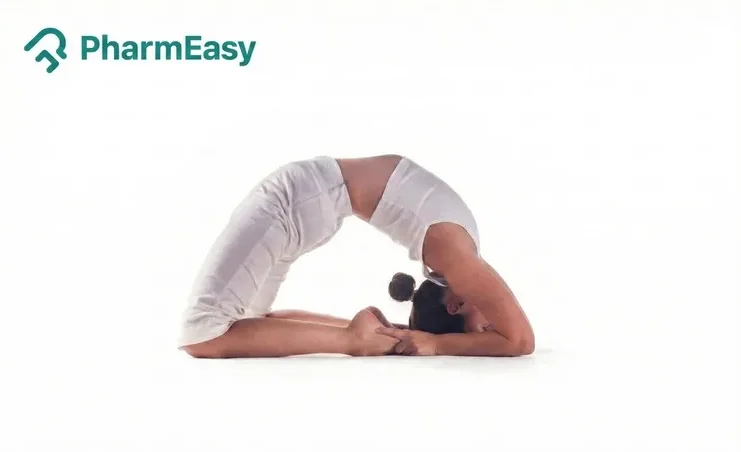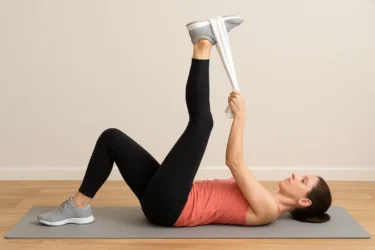Benefits of Kapotasana (Pigeon Pose) and How to Do it By Dr. Himani Bisht
By Dr. Himani Bisht +2 more

Get,

to manage your symptom
Get your,


4 Cr+ families
benefitted

OTP sent to 9988776655



You’ve successfully subscribed to receive
doctor-approved tips on
Whatsapp

Get ready to feel your best.

Hi There,
Download the PharmEasy App now!!


Register to Avail the Offer
Send OTPBy continuing, you agree with our Privacy Policy and Terms and Conditions

Hi There,
Sign up on PharmEasy now!!
Trusted by 4 crore+ families

OTP sent to 9988776655



You have unlocked 25% off on medicines




Code: NU25
By Dr. Himani Bisht +2 more
Table of Contents
In the 1800s yoga made its way from India to the Western part of the world. Charles Wilkins translated the Hindu text Bhagvat Geeta, which mentions yoga (asanas) in his book. Yoga gurus like Swami Satchidananda and the Maharishi influenced pop stars from Carol King to the Beatles. Yoga originated in the Indian subcontinent, consisting of various techniques to improve physical and mental clarity. Yoga consists of asanas (physical postures) pranayamas (breathing techniques) concentration techniques, chanting, ethical disciplines, and meditation. In the last 25 years, there has been numerous research to check the health benefits of yoga1. Let us glance through some of the health benefits of a posture kapotasana or pigeon pose benefits.

Kapotasana is also known as the pigeon pose or pigeon pose yoga. In Sanskrit, kapota means pigeon or dove, and asana means posture. Kapotasana opens your hip joints and helps your body to meditate more easily. This asana is an intermediate to advanced form of yoga. Reclines cradle, seated cradle, seated forward bend, and butterfly pose are some preparatory poses for kapotasana. Pigeon pose or pigeon stretch can have four variations pigeon pose, resting pigeon pose, one-legged king pigeon pose, and king pigeon pose2.
You can do the kapotasana pose in the following way:
Some of the interesting facts about kapotasana are:
Some of the potential benefits of kapotasana are as follows:

A study3 by Pandit and Vaidya in 2013 showed that a yoga protocol consisting of kapotasana might be beneficial in the case of asthma. Kapotasana may improve oxygen delivery and cellular respiration and increase the strength of lung muscles. However further studies are required to check if kapotasana may be beneficial in the case of asthma. However you must consult your doctor if you suspect asthma.

A study4 by Mehar and Navdeep in 2019 showed that a yoga protocol consisting of kapotasana might help to improve mental health. Yoga often encourages people to have an open heart. Kapotasana may expand the chest. This leads to the lesser judgment of oneself and gives a relaxed approach to life and greater acceptance of oneself. However, more studies are required to check if kapotasana can help to improve mental health. You must consult your doctor if you feel your mental health is hampered.

A study5 by Braun et al. in 2016 showed that a yoga protocol consisting of kapotasana might help to manage weight. The result of the study suggested that performing different asanas along with kapotasana may reduce body weight and BMI (body mass index). However, more studies are required to check if kapotasana may help to reduce weight. Therefore, you must consult your dietician to get a proper workout routine.

A study6 by Sathiyamoorthy and Karthikeyan in 2018 on college football players showed that a yoga protocol consisting of kapotasana might help to improve muscle flexibility. However, further studies are required to check if kapotasana can improve muscle flexibility.
As Kapotanasna involves stretching and strengthening of muscles of the pelvic floor and improves blood circulation, practising Kapotanasana might help in reducing visceral fat10.
Dr. Rajeev Singh, BAMS

A study by Iyer showed that a yoga protocol consisting of kapotasana might help reduce lower back pain. Kapotanasana may help to reduce sciatic discomfort7. However, further studies are required to check if kapotasana may help to relieve lower back aches. You must consult your doctor if you experience pain in your lower back for a prolonged period.

A study8 by Parmar et al. in 2017 on school students showed that a yoga protocol consisting of kapotasana might help to reduce stress levels. However, further studies are yet to be done to check if kapotasana may reduce stress levels. You must consult your doctor if your health is being hampered due to stress.
Yoga practice may help develop the mind and body however, it is not an alternative to any other medicine. Therefore, you must not rely on or depend on yoga alone to treat any condition. Instead, please consult a qualified doctor who can assess your condition and advise accordingly. Furthermore, it is necessary to practice and learn yoga under the supervision of a trained yoga teacher to avoid any injuries.
I would highly recommend Kapotasana to those people whose daily life involves lots of sitting or athletes who regularly indulge in sports like cycling or running. These activities might lead to the shortening and tightening of pelvic muscles like the rectus femoris and lliopsoas. Kapotasana might work around these muscles and provide strength to them9.
Dr. Siddharth Gupta, B.A.M.S, M.D (Ayu)
Also Read: Benefits of Malasana (Garland Pose) and How to Do it
The following risks may be associated with kapotasana:
With the guidance of a qualified and experienced yoga teacher/yoga expert, we can assess and analyze the risk factors and continue to practice kapotasana with precautions.
Also Read: Benefits of Virasana (Hero Pose Yoga) and How to Do it By Dr. Ankit Sankhe
Kapotasana is also known as the pigeon pose. In Sanskrit, kapota means pigeon or dove, and asana means posture. This asana is an intermediate to advance form of yoga. Kapotasana may be beneficial in the case of asthma. It may help to improve muscle flexibility. Kapotasana may help to manage weight and stress. It may be good for mental well-being and back pain.
Further, this asana, along with other yoga postures, may reduce stress in children. People with knee injuries and recent knee surgeries shall be cautious before doing this pose. People with spinal, abdominal, and hip injuries shall be cautious before doing this pose. People with less flexible and delicate wrists shall be careful before doing kapotasana. You must perform kapotasana under the guidance of a trained yoga professional.
Also Read: Benefits of Vakrasana (Spinal Twist Pose) and How to Do it By Dr. Himani Bisht
There are several benefits to performing pigeon pose yoga regularly. Kapotasana may be beneficial in the case of asthma. It may help to improve muscle flexibility. Kapotasana may help to manage weight and stress. It may be good for mental well-being and back pain. However, you must consult your doctor if you have any of the mentioned conditions instead of self-medicating3,8.
Pigeon pose can have four variations pigeon pose, resting pigeon pose, one-legged king pigeon pose, and king pigeon pose2.
Reclines cradle, seated cradle, seated forward bend, Cat and Cow pose, and butterfly pose are the preparatory poses for kapotasana2.
People with knee injuries and recent knee surgeries shall be cautious before doing this pose. People with spinal, abdominal, and hip injuries shall be cautious before doing this pose. People with less flexible and delicate wrists shall be careful before doing kapotasana2. You must perform kapotasana under the guidance of a trained yoga professional.
Yoga often encourages people to have an open heart. Kapotasana may expand the chest. This leads to lesser judgment of oneself, a relaxed approach to life, and greater acceptance of oneself4. However, you must consult your doctor if your mental health is hampered.
Disclaimer: The information provided here is for educational/awareness purposes only and is not intended to be a substitute for medical treatment by a healthcare professional and should not be relied upon to diagnose or treat any medical condition. The reader should consult a registered medical practitioner to determine the appropriateness of the information and before consuming any medication. PharmEasy does not provide any guarantee or warranty (express or implied) regarding the accuracy, adequacy, completeness, legality, reliability or usefulness of the information; and disclaims any liability arising thereof.
Links and product recommendations in the information provided here are advertisements of third-party products available on the website. PharmEasy does not make any representation on the accuracy or suitability of such products/services. Advertisements do not influence the editorial decisions or content. The information in this blog is subject to change without notice. The authors and administrators reserve the right to modify, add, or remove content without notification. It is your responsibility to review this disclaimer regularly for any changes.
Comments

Leave your comment...
You may also like
Comments